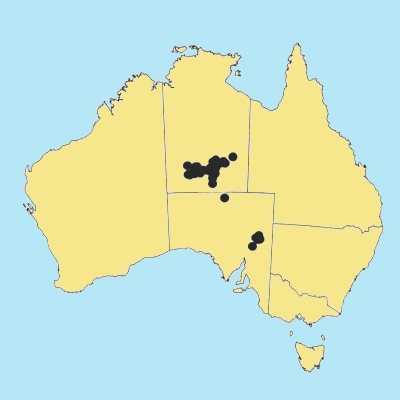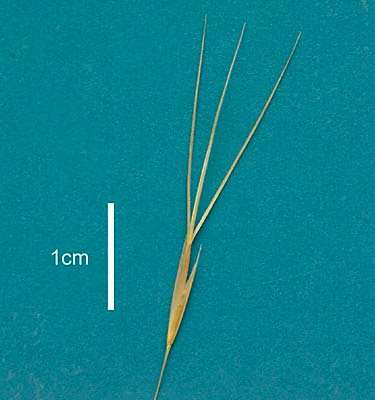Aristida arida B.K.Simon. Austrobaileya
2: 87 (1984).
Classification. (GPWG 2001) : Subfamily
Aristidoideae. Aristideae.
Type of Basionym or
Protologue Information: Australia: Northern Territory: Central Southern
Region, 20.5 mi SE of Alice Springs, 17 Aug 1956, M. Lazarides 5725 (HT:
BRI-21231; IT: CANB, MEL, NSW, NT, PERTH).
Key references
(books and floras): [2002] D.Sharp & B.K.Simon, AusGrass, Grasses of
Australia, [2006] J.Jessop, G.R.M.Dashorst, F.M.James, Grasses of South
Australia (319).
Illustrations:
[2005] K.Mallet (ed.), Flora of Australia 44B: Poaceae 3 (Fig.
20D-G), [2006] J.Jessop, G.R.M.Dashorst, F.M.James, Grasses of South
Australia (319, fig. 249).
Derivation: L.
dry. Growing in arid places.
Habit.
Perennial. Culms 40–80 cm tall, 2–4 -noded. Mid-culm internodes glabrous.
Lateral branches branched. Ligule a fringe of hairs, 0.3 mm long. Leaf-blades
straight, conduplicate or involute or convolute, 10–20 cm long, 1–2 mm wide.
Leaf-blade surface scaberulous.
Inflorescence.
Inflorescence solid, a panicle. Panicle linear, 11–40 cm long, 1–3 cm wide.
Spikelets.
Spikelets pedicelled. Fertile spikelets 1-flowered, comprising 1 fertile
floret(s), without rachilla extension, lanceolate, terete, 8–13 mm long.
Glumes. Glumes
similar, thinner than fertile lemma. Lower glume lanceolate, membranous,
keeled, 1-keeled, 1 -nerved. Lower glume apex awned. Upper glume lanceolate,
8–13 mm long, membranous, keeled, 1-keeled, 1 -nerved. Upper glume apex entire,
muticous.
Florets.
Fertile lemma 7–11 mm long, without keel, 3 -nerved. Lemma apex awned, 3
-awned. Median (principal) awn without a column. Lateral lemma awns present.
Palea without keels. Anthers 3. Grain 7.5 mm long.
Continental
Distribution: Australasia.
Australian
Distribution: Northern Territory, South Australia.
Northern Territory:
Central Australia South. South Australia: Lake Eyre, Flinders Ranges,
Eastern.
Notes.
A. arida is very similar to A. nitidula, differing in its uneven
glumes, and also to A. australis, which differs by the lemma indumentum
being completely smooth or very sparsely scaberulous.
Found
in a zone to the east and west of Alice Springs, Central Australia and two
localities in South Australia, one north-west of Lake Eyre and the other in the
vicinity of Lake Torrens. Generally associated with mulga (Acacia aneura)
on red earths, skeletal soil and sandstone. Flowering and fruiting all year but
mainly April to September.





